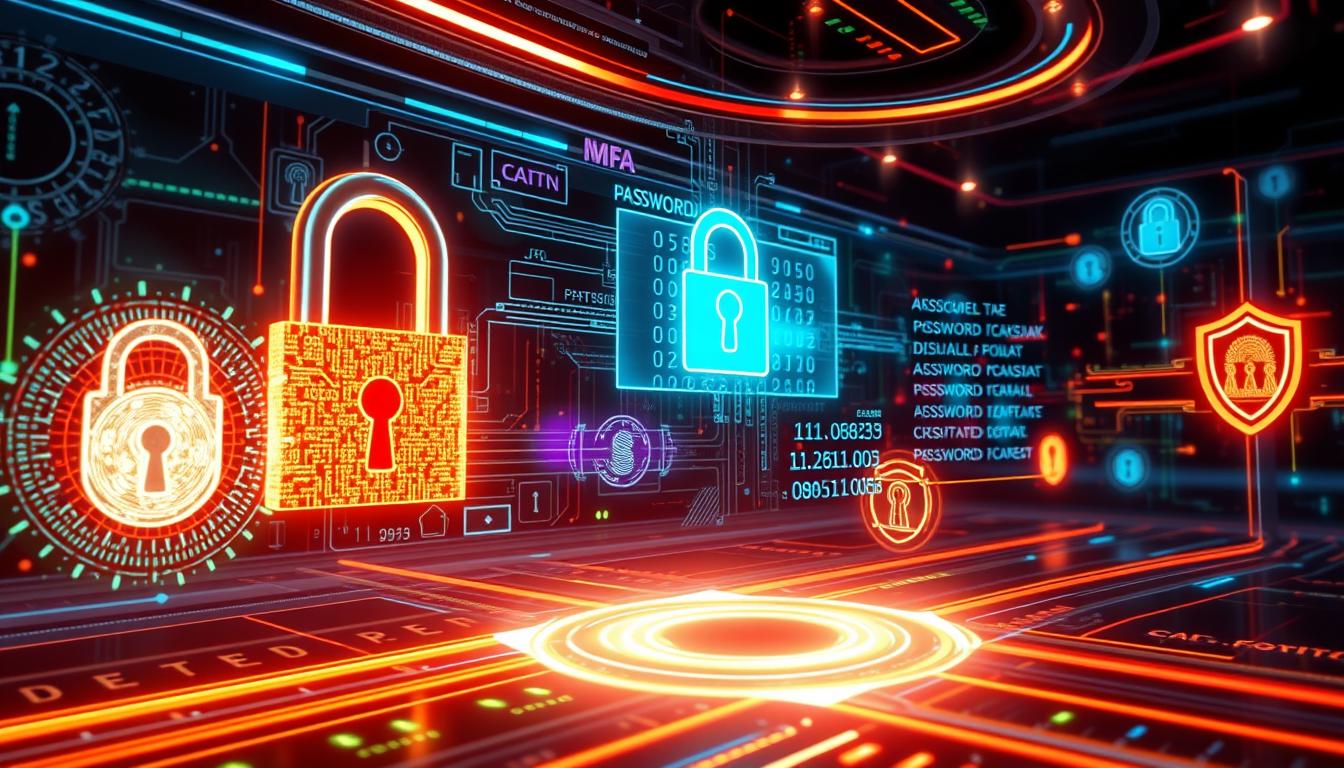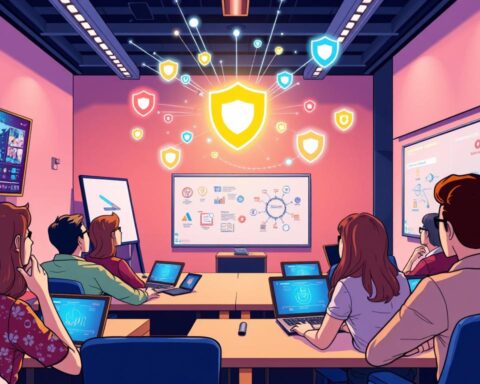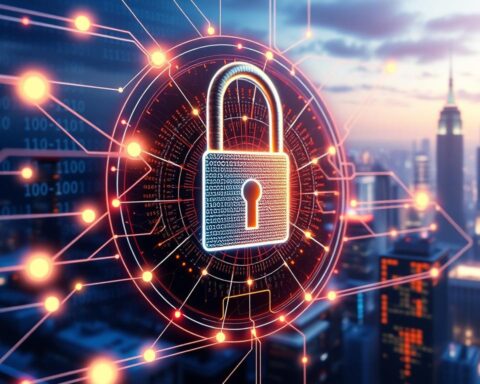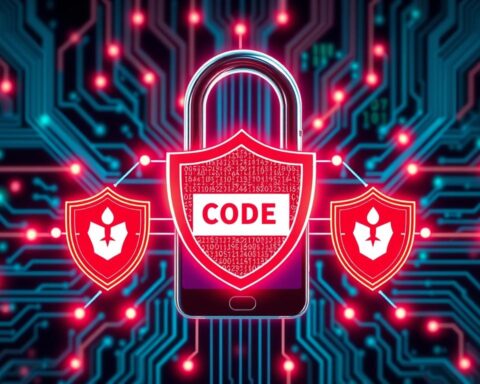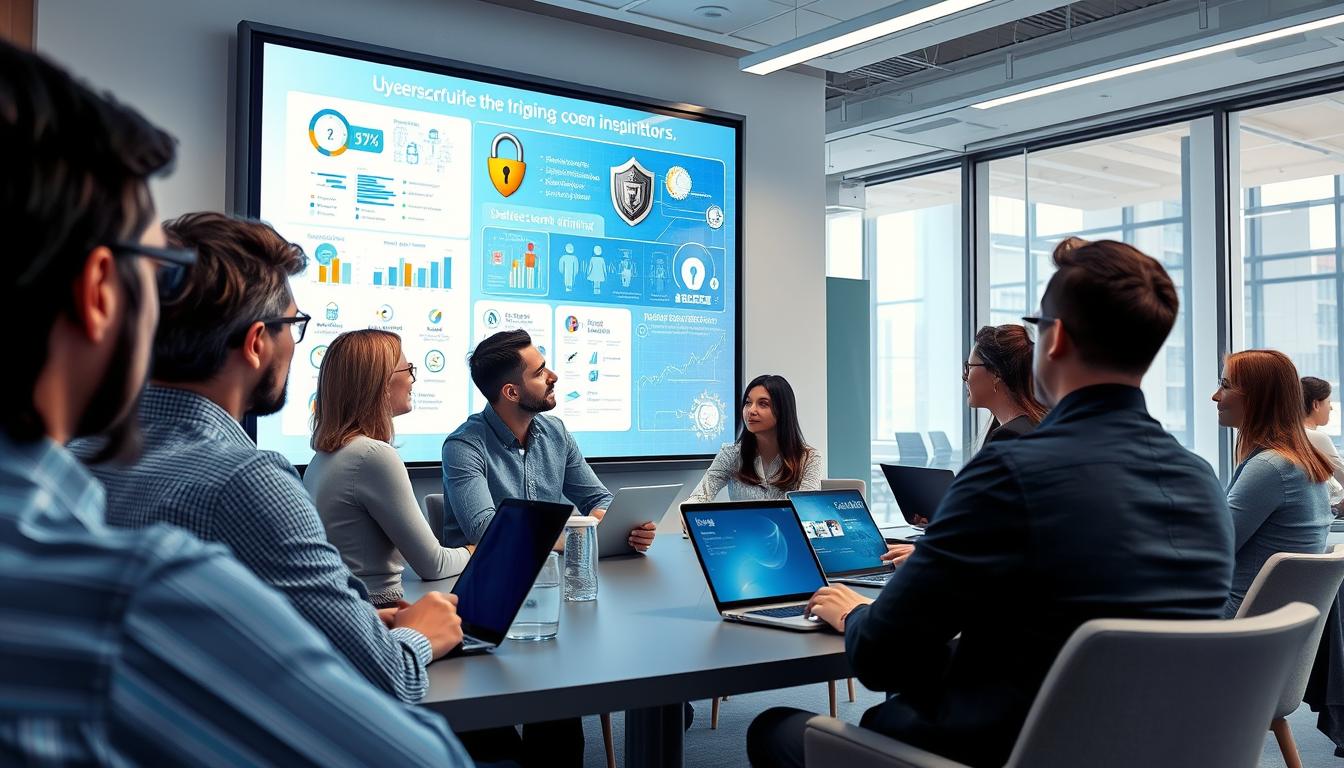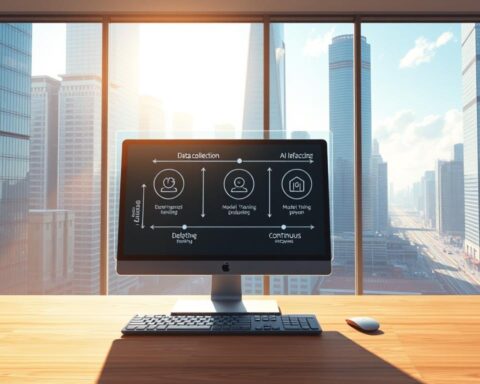In today’s digital world, 81% of data breaches come from weak passwords1. This makes strong authentication strategies more important than ever. Welcome to Day 16 of our Cybersecurity Training. We’ll explore advanced password management and MFA strategies to strengthen your defenses.
Did you know MFA can cut down credential theft attacks by 99.9%1? Yet, many organizations struggle with password weaknesses. A surprising 70% of employees reuse passwords, risking their company’s security1.
Today, we’ll look at the latest in secure authentication and multi-factor authentication. We’ll cover everything from biometrics to AI-powered systems. You’ll learn how to keep up with threats and protect your important assets.
Key Takeaways
- MFA implementation can reduce credential theft risks by 99.9%
- 81% of data breaches are caused by weak or stolen passwords
- Password reuse remains a significant security threat
- Advanced authentication methods include biometrics and AI-powered systems
- Regular employee training is key for strong security practices
- Using a centralized password vault can boost your organization’s security
Understanding the Critical Need for Enhanced Authentication Security
The digital world is changing fast, and we need better security. Cyber threats are getting smarter, so companies must update their password rules and how they manage credentials.
Current Cybersecurity Threat Landscape
The world of cybersecurity is getting scarier. In 2023, data breaches jumped by 20%, with 2,814 incidents reported2. This shows we really need to step up our security, focusing on passwords and how we log in.
Common Password Vulnerabilities
Weak passwords are a big problem. People often pick easy-to-guess passwords or use the same one for many sites3. Using a password manager can help by creating and keeping strong, different passwords for each site.
The Rising Cost of Security Breaches
Security breaches cost a lot of money. The average breach costs $4.24 million, so ignoring security is not an option4. Strong password rules and using MFA are key to keeping data and money safe.
“Multi-factor authentication is no longer optional; it’s a necessity in today’s threat landscape.”
Here are some key facts about MFA:
| Statistic | Impact |
|---|---|
| Risk Reduction | 99.9% less likely to suffer account compromise43 |
| Preventable Breaches | 80% of data breaches can be prevented4 |
| IT Professional Confidence | 67% believe MFA is highly effective against breaches4 |
As threats grow, so must our security efforts. Using password managers, strict password rules, and MFA is now a must for keeping our digital world safe in 2024 and beyond.
Advanced Password Management and MFA Strategies
In today’s digital world, strong security is key. Advanced password management and Multi-Factor Authentication (MFA) are vital in fighting cyber threats.
Strong passwords are essential, but they’re not enough. Hacking tools can break 96% of common passwords in under a second. Also, 70% of users reuse passwords across different sites5. This shows we need better password habits.
Password managers are a big help. They create complex passwords, making them much safer than what users come up with5. Companies using these tools see a 40% drop in breached accounts5.
MFA adds an extra layer of security. It can block up to 99.9% of automated cyberattacks, making it a game-changer6. Biometric authentication, a type of MFA, is becoming popular for its ease and security.
Single sign-on (SSO) systems make access easier while keeping it secure. They reduce password fatigue and lower the risk of attacks. Companies using SSO see better user experiences and more productivity.
The future of login is moving towards passwordless methods. These new approaches, like FIDO Alliance standards, could cut phishing attacks by over 90%6. As we move forward, combining advanced password management, MFA, and new technologies will be at the heart of strong cybersecurity.
| Authentication Method | Security Improvement | User Adoption |
|---|---|---|
| Password Managers | 40% reduction in breached accounts | 70% decrease in password reset requests |
| Multi-Factor Authentication | 99.9% prevention of automated attacks | 75% reduction in credential-based breaches |
| Single Sign-On | Reduced attack surface | Improved user experience |
| Passwordless Login | 90% reduction in phishing attacks | Increasing adoption rates |
Creating Strong Password Policies in 2024
Strong password policies are key in today’s cybersecurity world. As we move into 2024, companies need to update their plans to fight off new threats.
Minimum Length Requirements
Passwords now need to be at least 16 characters long. This is up from the old 12-character rule7. Longer passwords make it harder for hackers to guess them.
Character Complexity Guidelines
Creating complex passwords is important. Use a mix of letters, numbers, and symbols. But, don’t use common patterns. Password managers can help make and keep track of strong, unique passwords7.
Password Rotation Best Practices
Changing passwords often is no longer recommended. Instead, make strong, unique passwords for each account. Use passphrases – long strings of random words. They are both safe and easy to remember7.
Following these guidelines can greatly reduce cyber attacks. Companies that use strong passwords and multi-factor authentication see a 40% drop in security issues7. By focusing on these steps, businesses can improve their security and protect their important data.
Implementing Multi-Factor Authentication Systems
Secure authentication is key in today’s digital world. Multi-factor authentication (MFA) is a strong defense against unauthorized access. Over 80% of hacking breaches are due to weak login credentials, showing the need for better password and MFA strategies8.
Types of MFA Authentication Methods
MFA includes three main types: something you know (passwords), something you have (security tokens), and something you are (biometrics). Companies should use strong MFA for all systems to fight phishing and boost security9.
| MFA Method | Description | Strength |
|---|---|---|
| Passwords | Traditional knowledge-based | Basic |
| Security Tokens | Physical or digital devices | Strong |
| Biometrics | Unique physical traits | Very Strong |
Biometric Authentication Integration
Biometric methods like fingerprint scanning and facial recognition add a strong security layer. They are more secure than SMS codes8. Adding biometrics to MFA systems greatly improves an organization’s security.
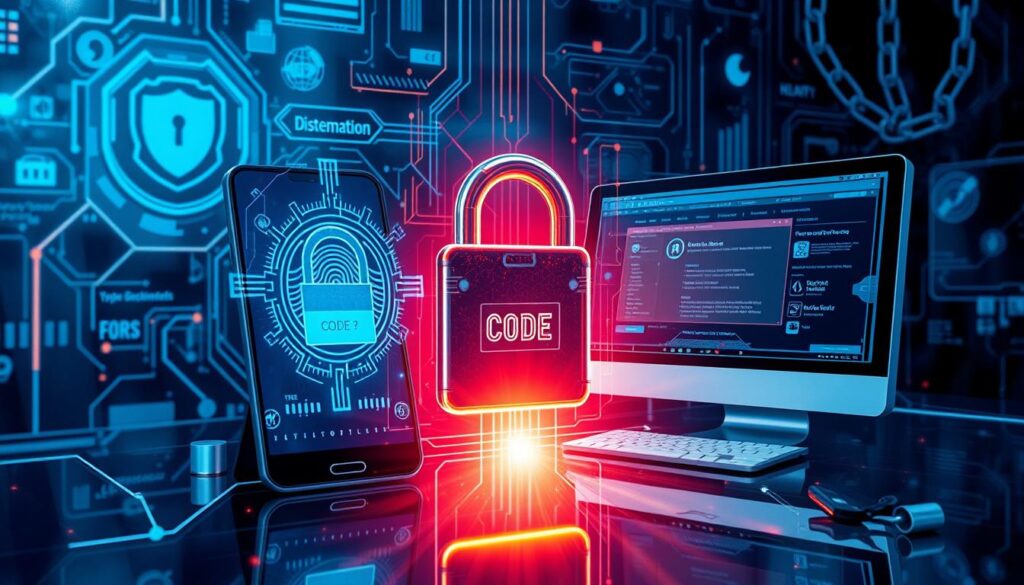
Push Notifications and Security Keys
Push notifications and security keys add more protection to MFA systems. Hardware-bound FIDO2 passkeys use public key cryptography, making user login almost phishing-proof9. These methods, along with strong passwords, help fight risks from weak or reused passwords8.
It’s vital to have MFA in all parts of an organization. Without it, there are big security gaps, making the company open to cyber threats9. By using these advanced MFA and password strategies, businesses can greatly improve their defense against unauthorized access and data breaches.
Password Manager Solutions for Enterprise Security
Password managers are key for keeping businesses safe. They help protect and manage passwords better. Yet, only 18% of people use them, leaving many at risk. Enterprise solutions offer strong features to fill this gap.
Securden and Keeper are among the best password managers. Securden makes sure passwords are changed often and uses top encryption10. Keeper has been secure for over 10 years and has many certifications11.
These tools make a big difference in security. Companies with password managers see a big drop in password problems10. Adding multi-factor authentication can cut down on unauthorized access by almost 100%12.
But password managers do more than just secure. They also make work easier by saving time and improving how well employees work12. They have features like access controls and audit trails to keep things in line and reduce threats by 40%12.
Getting a password manager is a smart choice. It can save money by preventing big breaches12. With the right one, you can make your business much safer and more efficient.
When picking a password manager, think about what your business needs. Look for easy integration, offline access, and a user-friendly design. The right tool can greatly improve your business’s security and how well it runs.
Securing Business Critical Applications with MFA
In today’s digital world, keeping business-critical apps safe is key. Multi-factor authentication (MFA) is a strong shield against unauthorized access. Companies using MFA see a 70% drop in security breaches, showing its power in protecting sensitive data13.
Cloud Service Protection
Cloud services need strong security. MFA adds a layer of protection by asking for two or more credentials. This can stop up to 99.9% of automated cyberattacks, making it a must for cloud security14.
Financial System Security
Financial systems are big targets for hackers. Using MFA is key to close security gaps. MFA can stop 99.9% of attacks on accounts, making it vital for financial security15.
Email and Communication Platform Security
Keeping email and communication platforms safe is essential for business. MFA in these areas cuts down data breach risks. It protects sensitive data and lowers the chance of expensive fines. Over 60% of companies say data breaches are their biggest cybersecurity worry, showing the need for strong authentication14.
Privileged access management is vital for securing apps. By combining MFA with Single Sign-On (SSO), companies can lower login numbers without losing security. This boosts protection and makes using apps better for everyone15.
To get the most from MFA, companies should regularly review policies and train employees. This keeps policies strong against new threats and makes sure employees know how to keep data safe1513.
Training Employees on Security Best Practices
Teaching employees about cybersecurity is key to keeping your company safe. With 83% of companies facing data breaches, it’s vital to focus on security training16. This training should include how to manage passwords, use secure authentication, and follow general cybersecurity guidelines.
It’s important to hold regular training sessions. Doing this monthly or every few months helps keep up with new threats16. By doing so, companies can save a lot of money and avoid big losses17.
Using fun and interactive training methods can really get employees involved. Things like simulations, games, and short learning modules can make training more engaging17. These methods help employees understand their role in keeping the company secure.
Training should be tailored to each employee’s role. This makes the training more relevant and effective17. It helps everyone understand their part in following password policies and using secure authentication. Also, encouraging employees to report any suspicious activity helps respond quickly to security threats16.
Creating a culture of proactive security is essential. With 1,636 cyber attacks per week in Q2 2024, a 30% increase from last year, training is more important than ever17.
Monitoring and Managing Authentication Systems
Good cybersecurity starts with strong monitoring and management of authentication systems. This is key to keeping secure authentication safe and sound.
Security Audit Procedures
Regular security audits are a must for a strong cybersecurity stance. They check on password policies, multi-factor authentication, and overall security. About 81% of data breaches come from weak or stolen passwords, showing how important audits are18.
Access Control Management
Role-based access control (RBAC) is key for limiting user access. It cuts down the risk of credential misuse and boosts security19. New Authentication frameworks like FIDO 2/WebAuthn ditch old passwords for safer options20.
Incident Response Planning
Being ready for security breaches is a must. A good incident response plan should tackle authentication issues. With 42% of breaches in the Verizon 2022 DBIR linked to stolen credentials, a solid plan is vital20.
| Authentication Method | Security Benefit | Implementation Rate |
|---|---|---|
| Multi-Factor Authentication (MFA) | Reduces account compromise risk by 99.9% | Widespread adoption |
| Biometric Authentication | Enhanced security through unique physical traits | 48% of organizations |
| Passwordless Authentication | Eliminates password-related vulnerabilities | Expected 60% adoption by 2025 |
Keeping authentication systems in check is vital. By 2023, 60% of cybersecurity pros aim to boost their strategies with machine learning18. This forward-thinking ensures security keeps up with new threats, keeping our digital world safe.
Future Trends in Authentication Security
The world of authentication security is changing fast. Soon, we’ll see more passwordless login and biometric authentication. Companies are also moving towards better password management and multi-factor authentication (MFA) to stay safe.
Passwordless Authentication
More and more, people are moving away from passwords. By 2024, 64% of companies plan to use passwordless methods21. This change is because 50% of users prefer using biometrics or security tokens over passwords21.
Biometric authentication is leading this change. The market for biometrics is expected to hit $76.37 billion by 2027, growing fast22. By 2024, 80% of MFA solutions will include biometrics21.
AI-Powered Security Systems
Artificial Intelligence is changing how we secure authentication. The AI MFA market is set to reach $4.1 billion by 2024, growing quickly22. These systems can spot unusual login patterns 95% better than before23.
AI-driven adaptive MFA is becoming key. 73% of cybersecurity experts say it’s vital for fighting new threats21. It adjusts security based on user behavior and risk, making security more effective.
| Authentication Method | Adoption Rate | Market Size Projection |
|---|---|---|
| Passwordless Authentication | 64% by 2024 | N/A |
| Biometric Authentication | 80% integration in MFA solutions | $76.37 billion by 2027 |
| AI-Powered MFA | N/A | $4.1 billion by 2024 |
Looking ahead, using these advanced methods will be key. With 81% of breaches caused by weak passwords, and MFA reducing risks by 99.9%, the future looks bright. But we must stay alert and keep adapting23.
Conclusion
Advanced password management and MFA strategies are key in today’s world. Sadly, 65% of people use the same password for many accounts24. This makes them easy targets for hackers.
Creating strong password policies is a good start. Passwords should be long and changed often24. But, passwords are not enough on their own.
Multi-factor authentication adds extra security. It requires more than one way to prove who you are24. This makes it harder for hackers to get in.
In the UK, 72% of companies have password policies now25. But, 28% are unaware of the dangers of weak passwords25. To stay safe, using password managers and MFA is essential.
Cybersecurity Awareness Month brings attention to these issues. But, we need to keep up the good work all year round. This is the only way to truly protect ourselves.
FAQ
What is multi-factor authentication (MFA), and why is it important?
How can organizations create strong password policies?
What are the benefits of using a password manager in an enterprise setting?
How can biometric authentication be integrated into MFA systems?
What are some effective strategies for training employees on cybersecurity best practices?
What is privileged access management, and why is it important?
How can organizations secure cloud services with MFA?
What is passwordless authentication, and what are its benefits?
How often should organizations conduct security audits of their authentication systems?
What role does artificial intelligence play in authentication security?
Source Links
- 20 Password Management Best Practices | 2025 – https://delinea.com/blog/20-password-management-best-practices
- Centralized Multi-Factor Authentication: Improve Security – https://www.encryptionconsulting.com/how-to-improve-security-using-centralized-multi-factor-authentication-mfa/
- Unlocking the Benefits of Multi-Factor Authentication for Enhanced Cyber Security – Intercede – https://www.intercede.com/unlocking-the-benefits-of-multi-factor-authentication-for-enhanced-cyber-security/
- Multi-Factor Authentication: Enhanced Security Guide | Attract Group – https://attractgroup.com/blog/the-importance-of-multi-factor-authentication/
- 10 Best Practices for Password Management – https://www.miniorange.com/blog/password-management-best-practices/
- Password management best practices – Article – https://www.sailpoint.com/identity-library/password-management-best-practices
- The Importance of Strong Passwords in 2024 – https://www.keepersecurity.com/blog/2024/07/10/the-importance-of-strong-passwords-in-2024/
- 10 Multi-Factor Authentication (MFA) Best Practices and Implementation Strategy – https://www.blog.darwinapps.com/blog/10-multi-factor-authentication-mfa-best-practices-and-implementation-strategy
- Top 8 tips for implementing MFA effectively – https://www.securitymagazine.com/blogs/14-security-blog/post/101152-top-8-tips-for-implementing-mfa-effectively
- Securden Password Manager for Enterprise – https://www.securden.com/password-manager/index.html
- Enterprise Password Management – https://www.keepersecurity.com/enterprise.html
- Workforce Password Management – https://www.cyberark.com/products/workforce-password-management/
- The Top Benefits of Multi-Factor Authentication (MFA) | ITonDemand – https://itondemand.com/2024/10/25/the-top-benefits-of-multi-factor-authentication-mfa/
- How to Implement Multi-Factor Authentication (MFA) in Your Business: A Step-by-Step Guide – https://www.totalbc.com/about/news/how-to-implement-multi-factor-authentication-in-your-business-_ae57.html
- Why Multi-Factor Authentication (MFA) is Important for Small Businesses – 9 Clouds – https://9clouds.com/blog/2fa-mfa-security-for-small-businesses/
- 10 Cybersecurity Best Practices Your Employees Must Follow – https://teampassword.com/blog/cybersecurity-best-practices-for-employees
- Cybersecurity Training for Employees: Best Practices, Courses – https://whatfix.com/blog/cybersecurity-training/
- 9 User Authentication Methods to Stay Secure in 2025 – https://www.strongdm.com/blog/authentication-methods
- What is Password Management? | Best Enterprise Password Management Software – https://www.securden.com/educational/what-is-password-management.html
- Advanced Authentication: The way forward – https://www.onelogin.com/blog/advanced-authentication-the-way-forward
- 10 Authentication Trends in 2024 and Beyond – https://www.tripwire.com/state-of-security/authentication-trends
- Future Trends in Multi-Factor Authentication: What to Expect – https://www.oloid.ai/blog/future-trends-in-multi-factor-authentication/
- What Is The Future Of Password Management And Authentication? – – https://www.controlaudits.com/blog/what-is-the-future-of-password-management-and-authentication/
- What Is The Best Way To Protect Passwords? – https://www.proserveit.com/blog/secure-password-management-best-practices
- Password Management and the Importance of Multi-Factor Authentication – Sota – https://sota.co.uk/password-management-and-the-importance-of-multi-factor-authentication/
